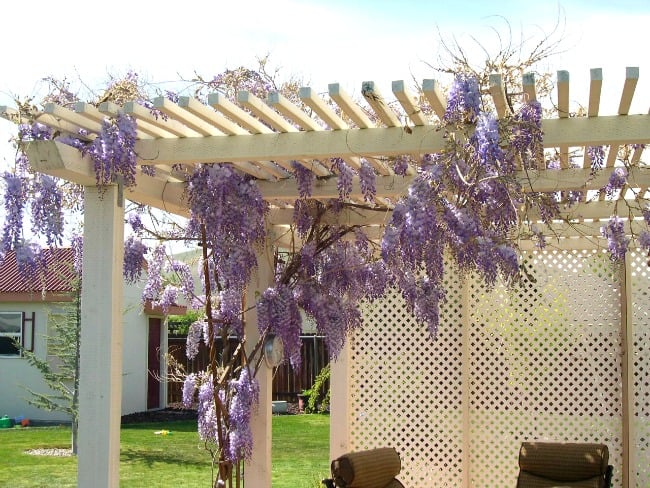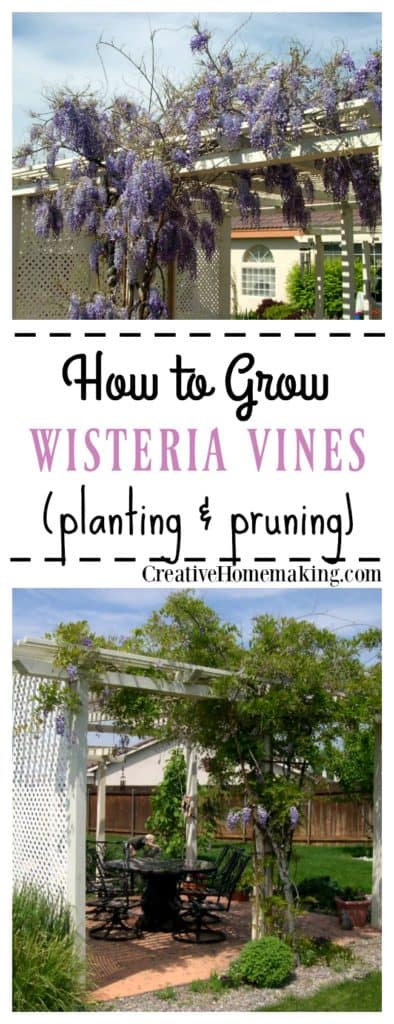Growing Wisteria Vines
This post may contain affiliate links.
Growing up I thought lilacs were the most fragrant spring flowers. It wasn’t until I moved into our current home that I was introduced to the fragrant wisteria vine, now another spring favorite!
My wisteria vine is now in full bloom, and almost nothing can compare to its large, fragrant purple flowers.
Wisteria is a deciduous climbing vine that is very hardy. It can grow very high and is known for its longevity. Two species of wisteria are common: Chinese wisteria (W. sinensis), and Japanese wisteria (W. floribunda).
Both can grow to a height of 25 feet or more. The Chinese variety bloom all at one time, and the Japanese variety bloom gradually over a period of weeks.
Chinese wisteria blooms grow to 6-12 inches in length and flower early to mid-May. Depending on the variety, flowers can be violet-blue, white, or dark purple.
Japanese wisteria clusters can grow 12-18 inches in length and bloom in late May. Depending on the variety, flowers can be several shades of pink, white, or several shades of violet.

Where to Plant Wisteria
Wisteria requires 6-8 hours of full sun each day and moist well-drained soil. Plants become large and heavy in time, so it will need some kind of support.
Wisteria grows best on structures such as pergolas, trellises, and arbors. Ours is growing over the top of a pergola. If you are on a budget you may want to look into DIY ways to make a these kinds of structures.
Keep in mind that older plants have a trunk several inches in diameter. Make sure the support can handle the weight of a heavy vine; some purchased structures will not be able to handle the weight of a well established wisteria vine.
In addition, don’t plant a vine too close to rain gutters and other structures on your home or they may cause serious damage in time.
How to Prune Wisteria Vines
Pruning is required to keep your wisteria from taking over. You can trim off the top of the main branch when it has reached an optimum height.
Train the main branch on the support you have attached it to, and trim and train side shoots as necessary to achieve the desired shape.

In the winter you can completely remove poorly spaced branches to improve the overall look of the vine.
Pruning in late spring or early summer, after bloom time, will promote future flower production.
You can cut back vines to 5 or 6 buds remaining. Pruning will actually accelerate the growth of your vine.
If you over-prune your wisteria, however, don’t fret, it will grow back next year and then some.
Waiting patiently for your wisteria to bloom? If you have just planted your wisteria vine, the vine goes through a “juvenile” stage where it does not bloom for up to 7 years, so be patient and keep pruning and training the vines until the blooms appear.
Make sure to plant root cuttings or grafted plants, wisteria grown from seed can take more than 10 years to achieve its first blooms.
Related Articles
- Guide for Planting Wisteria
- How to Trim or Prune a Rhododendron
- The Best Shade Plants for a Shady Side of a House
- Tips for Growing Lilacs
- 4 Creative Ideas for Vertical Gardens
Follow my gardening board on Pinterest.

In case you missed it:



Hello,
We had a metal arbor installed, have used 16 gauge cable and eye hooks to train up to the top of the pergola. Will the wisteria eventually take to the cable? We’ve twined it around the cable but the tips hang off. It’s only been a few days. Having trouble seeing pics on what the attachment of the vine should look like. Thank you for any info.
-T
Think you just saved me a nightmare:)
Just a note here. While beautiful Wisteria are invasive and in SC where I live they are not sold and are not recommended to plant.